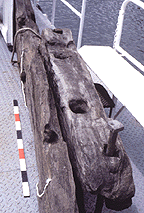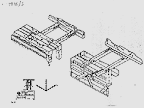Glossary
Back to "Lady Sherbrooke"
Homepage

The Clutch of the P.S. Lady Sherbrooke





On the P.S. Lady Sherbrooke there was two clutches, one for each paddlewheel. Two images of the anchor for the clutch, from the port side, are shown here. The anchor which held the clutch in place was left behind when the vessel was scuttled, probably because it was not seen as worthwhile to remove it for reuse on another vessel. However, the clutch (as well as most of the engine parts) was removed, for reuse on the P.S. John Molson, when the boat was retired in 1826.

The clutch was composed of two large cast iron disks. One disk was fixed to the axle of the paddlewheel with the other sliding. A lever placed under the clutch moved the sliding disk thereby engaging the motor.
The design of the boat, with the two paddle wheels each having there own clutch, and in turn individual power sources, allowed for the boat to be steered by controlling the power supplied to the paddle wheels. To turn to the left the paddlewheel on that side, the port side, was stopped. With the right or starboard side paddlewheel continuing to turn the boat would turn to the left. This manner of steering is still used today in some types of heavy duty equipment and in tanks with two track systems. On the Lady Sherbrooke the assistance offered by the paddlewheel to steer the vessel explains why the rudder was relatively small.
Because the clutch was such an important element for the continued functioning of the boat the manufacturers Boulton and Watt produced many spare parts in case of accidents or breakages. It may be easy to forget by the standards seen today but in the time of the Lady Sherbrooke there were not garages on every corner that could repair engines, and parts coming from England could force the interruption of service for the vessel.
